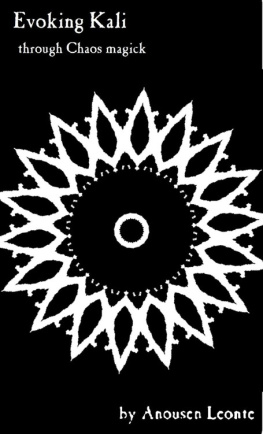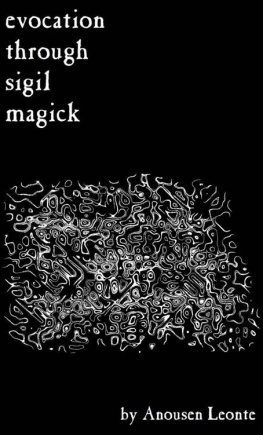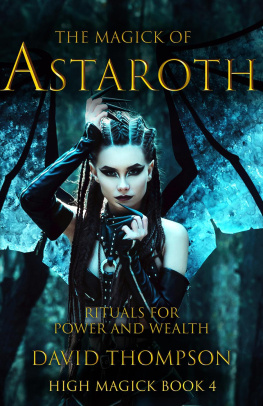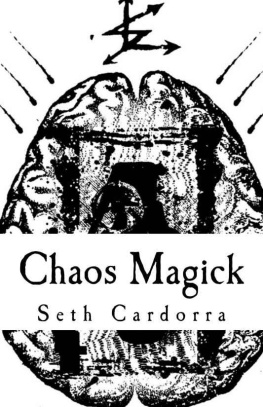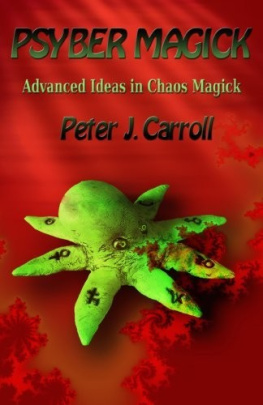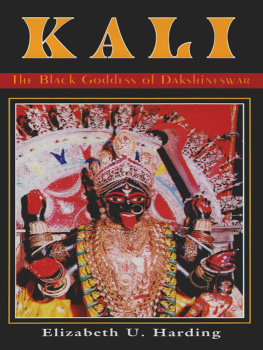Anousen Leonte - Evoking Kali through Chaos Magick
Here you can read online Anousen Leonte - Evoking Kali through Chaos Magick full text of the book (entire story) in english for free. Download pdf and epub, get meaning, cover and reviews about this ebook. year: 2016, genre: Religion. Description of the work, (preface) as well as reviews are available. Best literature library LitArk.com created for fans of good reading and offers a wide selection of genres:
Romance novel
Science fiction
Adventure
Detective
Science
History
Home and family
Prose
Art
Politics
Computer
Non-fiction
Religion
Business
Children
Humor
Choose a favorite category and find really read worthwhile books. Enjoy immersion in the world of imagination, feel the emotions of the characters or learn something new for yourself, make an fascinating discovery.
- Book:Evoking Kali through Chaos Magick
- Author:
- Genre:
- Year:2016
- Rating:4 / 5
- Favourites:Add to favourites
- Your mark:
- 80
- 1
- 2
- 3
- 4
- 5
Evoking Kali through Chaos Magick: summary, description and annotation
We offer to read an annotation, description, summary or preface (depends on what the author of the book "Evoking Kali through Chaos Magick" wrote himself). If you haven't found the necessary information about the book — write in the comments, we will try to find it.
Evoking Kali through Chaos Magick — read online for free the complete book (whole text) full work
Below is the text of the book, divided by pages. System saving the place of the last page read, allows you to conveniently read the book "Evoking Kali through Chaos Magick" online for free, without having to search again every time where you left off. Put a bookmark, and you can go to the page where you finished reading at any time.
Font size:
Interval:
Bookmark:
by Anousen Leonte
Copyright 2016
other works by the author:
Evocation Through Sigil Magick
Sigil Magick: the Basics
Scrying Without Tears
Olympick Magick
Gnostic Magick
Mythology and Nature of Kali
Kali is one of the more famous (or infamous) of Hindu deities. She is especially popular in the Westthough probably not for the right reasons. Many people are attracted to her outrageous image and are content to wear it on a t-shirt, but have little to no understanding of her true implications. To many Hindus, Kali is far more than a "cute" display of counter-culture. She is a symbol of the cosmos in all its divinity and totalityat once the wrathful Goddess of Death and the sublime and merciful Mother of All. For thousands of years she has been worshiped and summoned in magickal rites and I think she is a particularly excellent way to connect with magickal power. Unfortunately, the Greek and Egyptian Gods and Goddesses were replaced by the monotonous Christian and Islamic "God', but Kali continues to be worshiped to this very day in India and among the Hindu diaspora. Many people of other cultures have also found her worship to be an inspiring and beneficial addition to their Spiritual practiceespecially considering how many cultures were uprooted by forced monotheism. For practitioners of chaos magick, the aesthetic beauty of Kali is obvious and, like Hecate, her associations with the practice of magick and tantra in India make her an excellent choice of a Goddess to work with in a magickal setting. In this small booklet, I will be summarizing some of the common symbolism and mythology associated with her, as well as describing in detail a method of evoking herboth in a few traditional ways as well as the more modern method of sigil magick. Keep in mind that this is not a stand-alone booklet, however, and I will be recommending some other books to consult. I will describe everything you need to get started but you will definitely want to expand your study and knowledge of Kali eventually. You should also either have a working knowledge of astrological correspondences or a decent book which describes them in detail.
The word Kali derives from the Sanskrit word kal which means both time and black. She is most often worshiped via methods known as tantra in Hinduism. Tantra is a form of Spiritual practice which encompasses mysticism, yoga and magick, and is similar in many respects to Western ceremonial magick. Special diagrams are used called yantras in addition to special prayers or words-of-power called mantras. The practice of tantra is vast and multifaceted and there's no way I can truly do justice to it in such a small book, but if you wish to learn more about Kali and the traditional practices and philosophical theories associated with her, a study of tantra is where you should begin. One of the beautiful aspects of tantra is that it was a way of Spiritual practice for marginalized elements of society. Some sects of Hinduism were devoted to the ancient caste system and when these sects were in power, women and men considered low-caste or outcast were oppressed and forbidden to worship in certain temples and perform certain rites. Tantra, however, was open to all members of society regardless of sex or caste. It actively denounced patriarchy and racism by praising women and outcastes and vilifying the male brahmin hierarchy. True to form, it focused on the deities and magickal rites of those who were excluded from the upper echelons of society and gradually these deities were incorporated into Hindu mythology as a whole. Shiva, Kali and Ganesha are some of the more popular forms of these out-caste deities and tantra was their unique form of worship.
But who is Kali, exactly? In most types of Hinduism, the Goddess (Devi) is One, though has many different forms. Therefore such Goddesses as Sarasvati, Durga and Uma are all interchangeable, though representing different aspects and attributes. Kali is the form of the universal Goddess most associated with magick, death and chaos, but all aspects of the Goddess can be accessed through her. It is a characteristic feature of Hinduism that though a God or Goddess may have certain prominent characteristics, it can nevertheless be worshiped and summoned as possessing all characteristics, for the One is reflected in the many just as the many is reflected in the One. Each God or Goddess also possesses both wrathful and serene formsa feature which is also found in Tantric Buddhism, of which Tibetan Buddhism is the most widely known type. However, Kali is a uniquely magickal Goddess and almost a perfect parallel to the Greek Goddess Hecate. It is for this reason that I wanted to write a book of chaos magick devoted to her, as she is particularly evocative to magicianschaos magicians especially.
There are many different myths regarding Kali's origins. The most popular myth recounts that she was an emanation of the Hindu Goddess Durga. While in battle with a demon known as Mahisa and his armies, Kali emanated from Durga's head as a manifestation of pure wrath. She then proceeded to destroy Mahisa's demons one by one in a frenzy of destruction. After a demon was killed, Kali would remove its head and string it along a chain, forming her necklace of skulls. When all the demons lay dead, however, her lust for destruction did not end and she began to attack anyone and everyone she saw. Because she was so powerful, none could stop her bloodshed until finally the God Shiva set himself down in front of her path. Once she stood upon Shiva, her wrath was assuaged and she returned to a benevolent aspect. In this myth we see her dual roles: destroyer, Goddess of death and serene Mother. In another mother, Kali and another Goddess named Chandi were at war with a demon known as Raktavija. Every time they struck Raktavija, his blood would fall to the ground, giving rise to new demons. Kali was about to be destroyed until Chandi came to her aid. Chandi attacked Raktavija directly while Kali swallowed the drops of blood. Then, finally, Raktavija was slain. There are many other myths which you should familiarize yourself with if you wish to perform Kali-inspired magick, and each myth has its own lesson and meaning.
The most common depiction of Kali is a humanoid Goddess with four arms. In one arm she holds a severed head and in another arm she holds her sword. Her other two hands are outstretched in encouragement of her devotees. Another depiction has her holding a bowl beneath the severed head in order to catch its blood, with her other hand bloody and outstretched, mocking her enemies. In yet other depictions she holds a sword, a club, a noose and a bowl of blood, while still other depictions have her holding Shiva's characteristic tridenta parallel to the Satanic pitchfork. Of course, these weapons and Kali's violent nature are not interpreted by Hindus to mean that she is especially sinister. She is hell to her enemies but heaven to her devotees, and her weapons represent her awe-inspiring destructive and protective power.
One of the most beautiful texts devoted to Kali is the famous Hymn to Kali, translated by Arthur Avalon. It is freely available online but I would recommend both purchasing a hard copy as well as a transliteration of the original Sanskrit. Perfect Sanskrit pronunciation is beyond the capacity of most Westerners I'm sure, but it only takes a day or so to learn the way the different diacritic marks are pronounced. There is a beautiful, subtle and magickal state of mind that comes from reciting Sanskriteven imperfectlyand I would recommend reciting both the Hymn to Kali and her 108 names as a way to augment your magickal performance. Arthur Avalon's translation also describes the symbolism and meaning of the hymn in detail, giving you a well-rounded vision of Kali in all her implications.
Font size:
Interval:
Bookmark:
Similar books «Evoking Kali through Chaos Magick»
Look at similar books to Evoking Kali through Chaos Magick. We have selected literature similar in name and meaning in the hope of providing readers with more options to find new, interesting, not yet read works.
Discussion, reviews of the book Evoking Kali through Chaos Magick and just readers' own opinions. Leave your comments, write what you think about the work, its meaning or the main characters. Specify what exactly you liked and what you didn't like, and why you think so.

